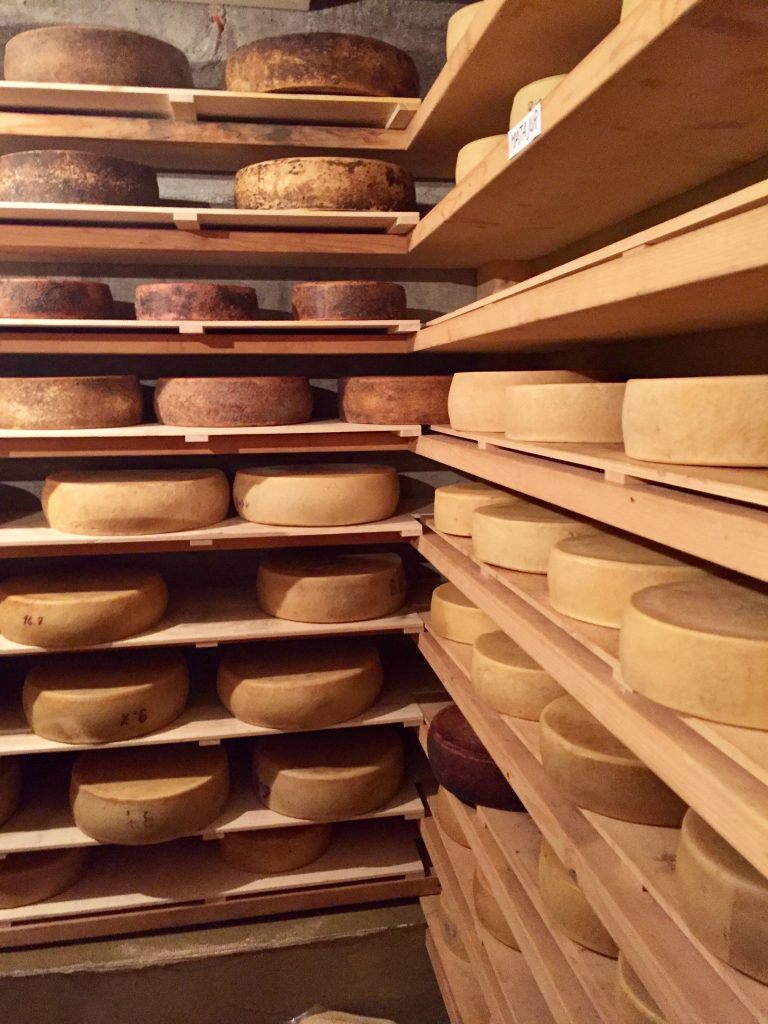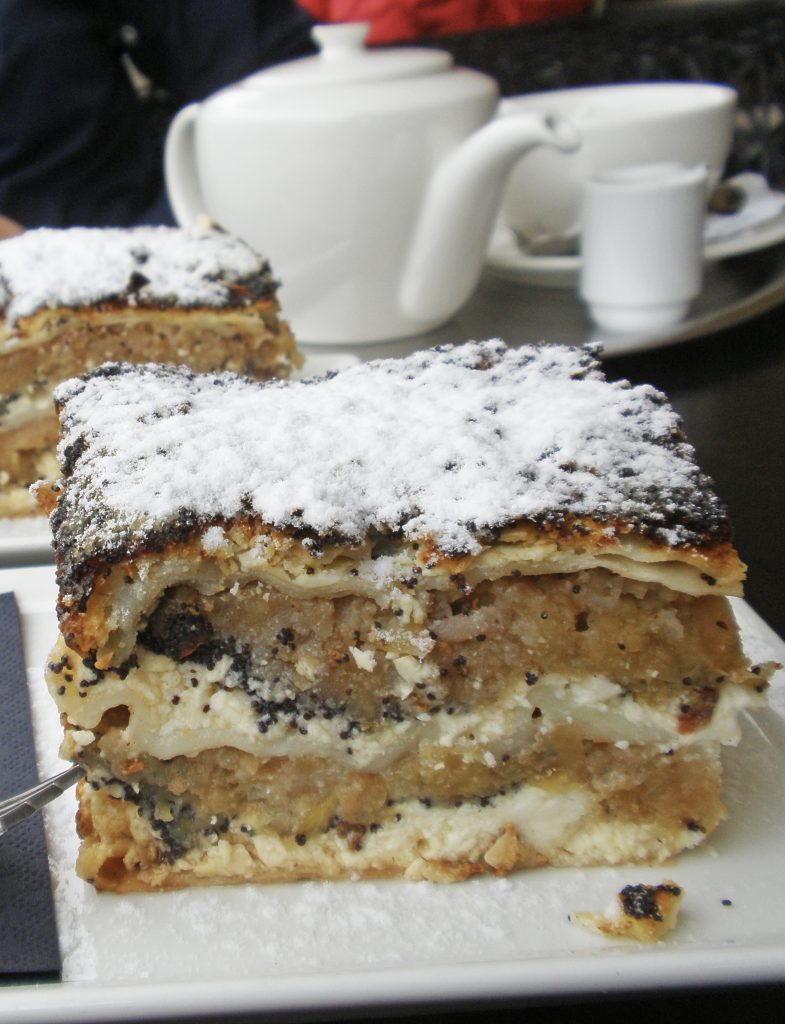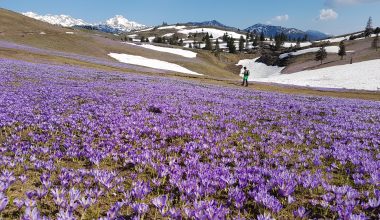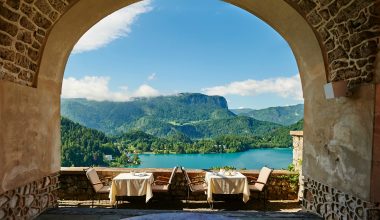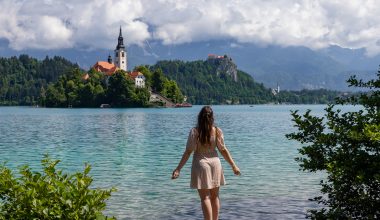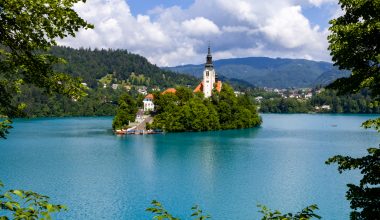I am vegetarian but I didn’t cut out all meat options from this list on purpose. They’re just pretty uninspiring including stews and sausages. So I actually find these vegetarian options more interesting. Unfortunately not a lot of this list is vegan friendly – the food here seems pretty reliant on cheese and butter.
Some of these are not that common, or are regionally specific. However, these are the ‘traditional’ Slovenian treats I’d suggest you look out for if you want the full culinary experience. Look out for these dishes whilst you’re in Slovenia and let me know if you try any!
Frika
Frika was our favourite thing we tried in Slovenia. It’s an indulgent dish of potatoes and Tolminc cheese in a fried pan sized patty, and it’s cut and served over a block of polenta. We had it twice, and the best one was from Bovec Kitchen / Bovška Kuhn’ca food stall in Bovec. They serve it with a chive yoghurt which really livened it up. Frika can most often be found along the Soča valley and across the border in Italy. If you’re vegetarian it’s worth checking it hasn’t been fried with pancetta or in pork fat.
If you head to Bovec Kitchen, it’s closed on Mondays and Tuesdays and otherwise only open in the afternoon. You can find their opening times on google. I also highly recommend the waffles from the neighbouring stall Paulačinka.
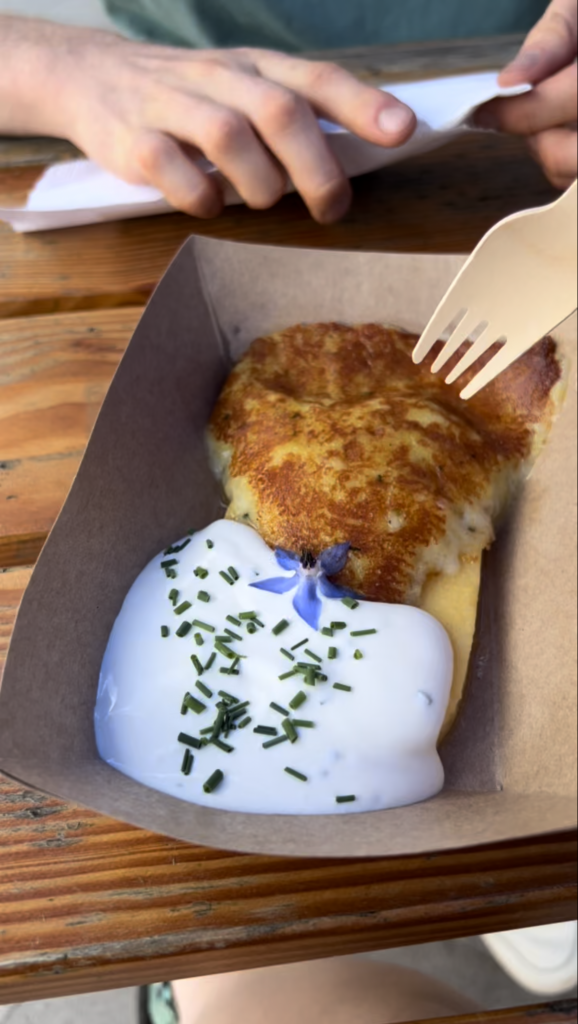
Burek
Burek is a popular dish, similar to börek in neighboring countries. It’s made with layers of flaky pastry with various fillings. The most common we found were cheese, which we think was cottage cheese, and spinach and cheese. The latter was our favourite between them. The pure cheese version felt a bit heavy and like it needed a salad to go with it! There were also occasionally meat options.
Burek can be found for a few Euros from supermarket hot / bakery counters and bakeries all over Slovenia.
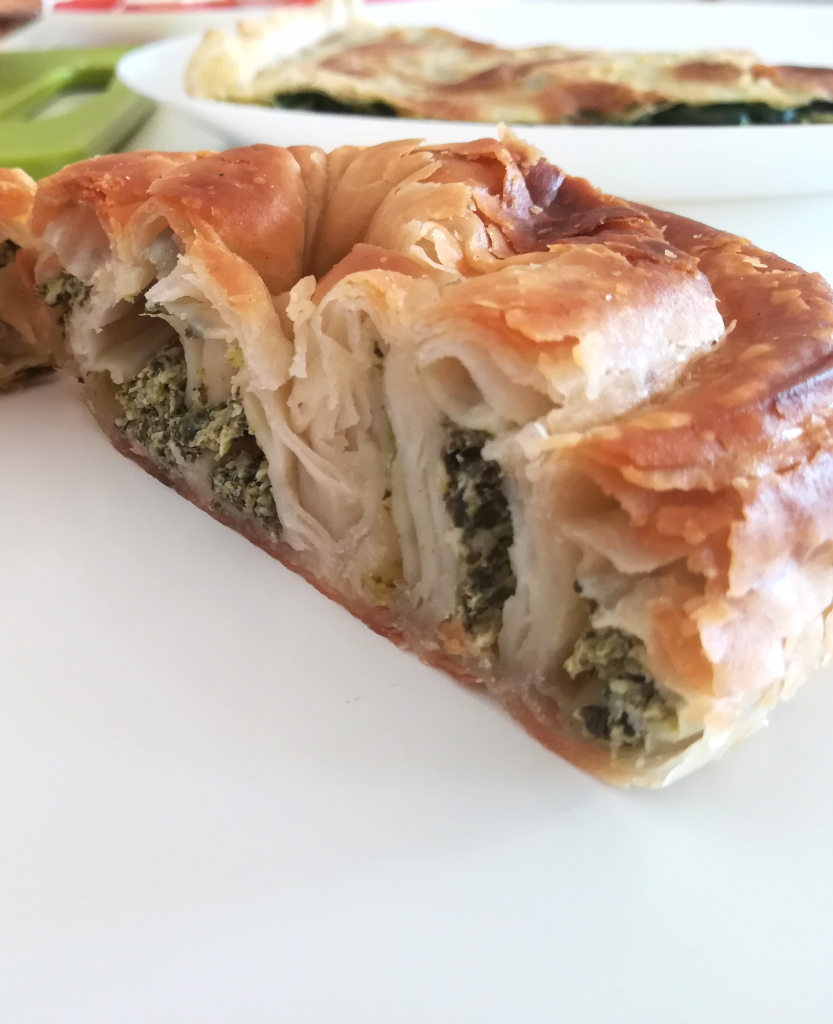
Idrijski žlikrofi
Idrijski žlikrofi are a Slovenian culinary specialty hailing from the town of Idrija. Similar to ravioli, these delicate dumplings are crafted from thin pasta dough, meticulously hand-folded into distinctive horseshoe shapes, and traditionally filled with a mixture of potatoes, onions, and various savoury seasonings. Often served with a meat stew, but can be served on their own with breadcrumbs or a sauce for vegetarians.
Ajdovi žganci – Buckwheat Spoonbread
Ajdovi žganci, a traditional Slovenian dish, are buckwheat dumplings known for their rustic and hearty character. Prepared by cooking buckwheat flour with water, ajdovi žganci possess a unique earthy flavour and slightly gritty texture. Typically served alongside various savory accompaniments like sausages, sauerkraut, or mushroom sauces, this dish provides a taste of Slovenia’s rural culinary heritage and remains a comforting staple in the country’s cuisine. This dish is often enriched with lard or cracklings, so you might want to check it hasn’t been cooked in animal fat if you are strictly vegetarian.
Try it at Restaurant Zeleni Rob at Velika Planina.
Trnic cheese
Trnič cheese is a culturally significant dairy product originating from the Dolenjska region of Slovenia. Crafted using a blend of cow, goat, and sheep milk, trnič cheese is traditionally formed into distinctive conical shapes, showcasing intricate patterns and designs that are often pressed into the surface with wooden molds. Aged for several months, the cheese develops a semi-hard texture and a rich, complex flavor profile with nutty and tangy notes. Trnič cheese holds deep historical and artisanal value, representing a centuries-old tradition that has been revived in recent years, showcasing the craftsmanship and culinary heritage of the region. You can learn more about this at Velika Planina.
Tolminc cheese
Tolminc cheese, originating from the Tolmin area of Slovenia, is a renowned semi-hard cheese with a distinct character. Crafted from cow’s milk, Tolminc cheese is typically aged for varying lengths of time, resulting in different flavor profiles and textures. Young Tolminc is mild, creamy, and slightly nutty, while aged versions develop a more robust taste with crumbly texture and pronounced savory notes. This cheese reflects the alpine traditions of Slovenia, often enjoyed on its own or as a key ingredient in local dishes, and it stands as a testament to the country’s rich cheesemaking heritage.
Struklji
Struklji, a traditional dish from Slovenia and parts of Croatia, are rolled or folded dumplings made from thin dough that is filled with a variety of sweet or savory fillings. The dough is usually rolled out, spread with the chosen filling – often cottage cheese – and then rolled or folded to encase the filling. The Struklji are then boiled.
They can be served as a savoury or a dessert, and their preparation and fillings can vary based on regional and personal preferences. We tried savoury cheese strukliji and they were served in butter and topped with salty breadcrumbs. We didn’t like them much and would really recommend you try the sweet versions as the fruit they are served with would really bring these to life.
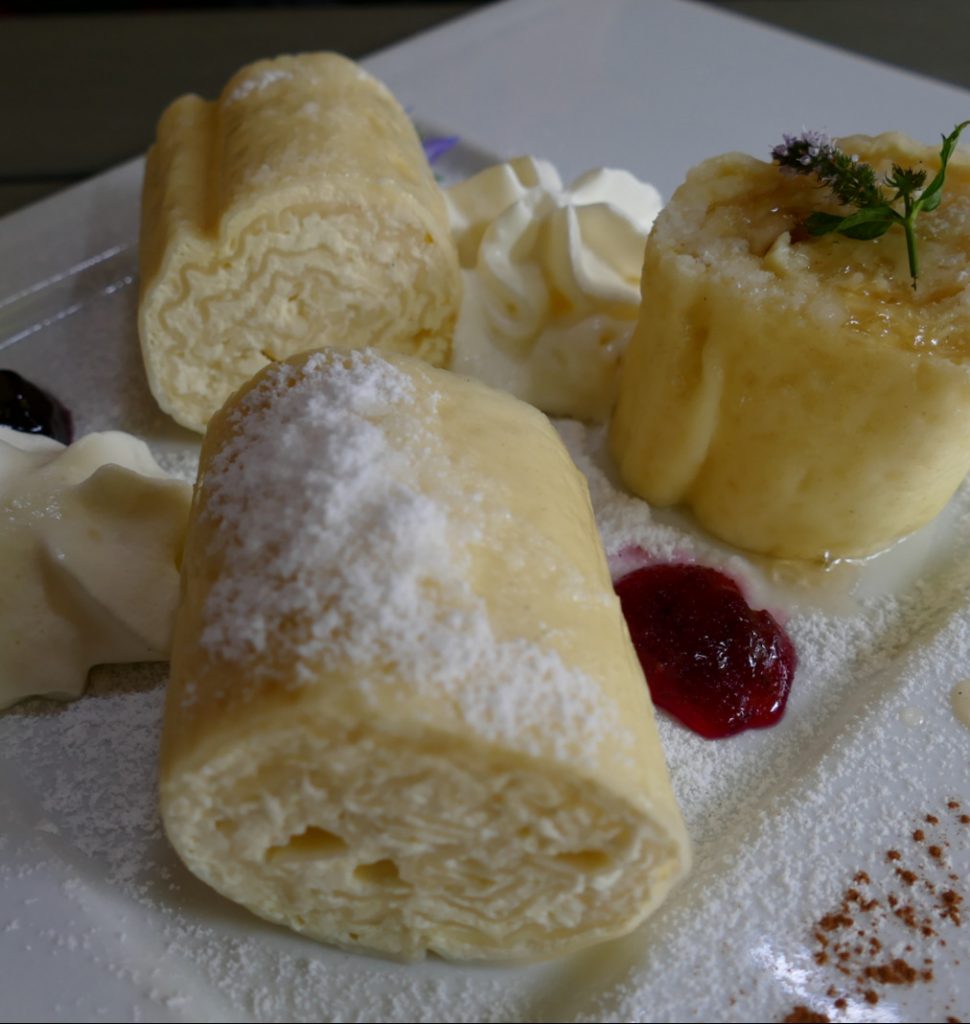
Strudelj
In Slovenia, strudel, known as “štrudelj,” is a popular pastry that reflects the country’s culinary influences from neighboring regions. Štrudelj is typically made by rolling out a thin layer of dough, which is then filled with ingredients such as apples and cherries. The filling is spread over the dough, and the pastry is rolled or folded to encase the filling. After baking, štrudelj emerges with a crispy, flaky crust and a flavorful interior. We found that the strudel in Slovenia varied as to whether it came crispy or soft. Being used to a crispy strudel, the soft version was a surprise!
Prekmurian layer cake
Prekmurska gibanica, or Prekmurian layer cake, is a traditional Slovenian dessert originating from the Prekmurje region in the northeastern part of the country. This pastry is made by layering several thin sheets of dough, each spread with a different filling. The fillings typically include poppy seeds, ground walnuts, apples, and cottage cheese, often seasoned with sugar, cinnamon, and sometimes raisins. The layered dough and fillings are carefully stacked in a baking dish and then baked until the cake achieves a golden and crispy exterior. Prekmurska gibanica is renowned for its unique combination of sweet and savory flavors, and it holds cultural significance as a beloved treat served during various celebrations and events in Slovenia.
Potica cake
Potica is a traditional Slovenian roll that holds a special place in the country’s culinary heritage. The loaf consists of a sweet yeast dough that is rolled thin and spread with a variety of ingredients, most commonly ground walnuts, sugar, butter, and sometimes honey or spices. The dough is then carefully rolled into a spiral shape, creating layers of filling within the cake. Potica comes in various regional and creative variations, with fillings ranging from poppy seeds and tarragon to cottage cheese and dried fruits. It is typically baked served in slices. The Potica we had and have read about is actually quite dry and we think it’s better thought of as a bread. You can try Potica from a specialist in Lake Bled.
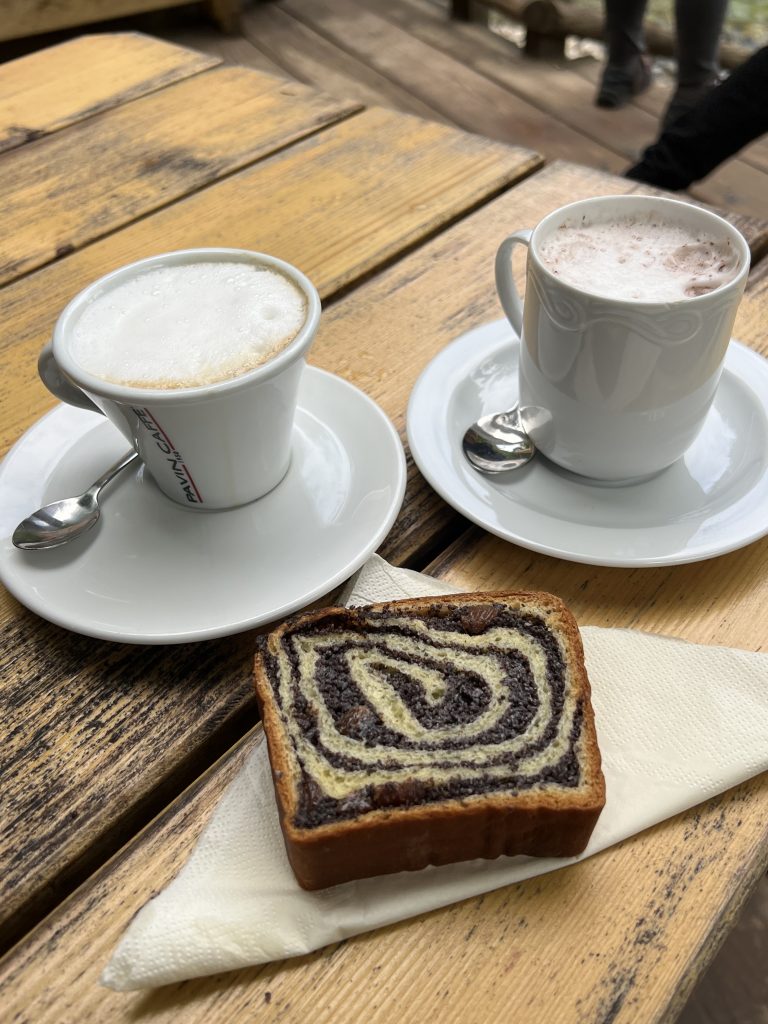
Bled cream cake
The Bled cream cake, referred to as ‘Blejska kremna rezina’ in Slovenian, is a famous dessert in Bled, Slovenia. This treat features two delicate layers of puff pastry sandwiching two substantial layers of cream and vanilla custard, often topped with a dusting of powdered sugar. Locals and tourists alike relish the Bled cream cake, solidifying its status as a culinary emblem of Bled, attracting numerous enthusiasts every year.
We’ve been honest before and said that we didn’t like Bled cream cake. It originated at Park Cafe and that cafe itself has tens of other patisseries with much more flavour. However, people seem to love it.
For a vegan version of Bled cream cake, head to Public & Vegan Kitchen in Bled.
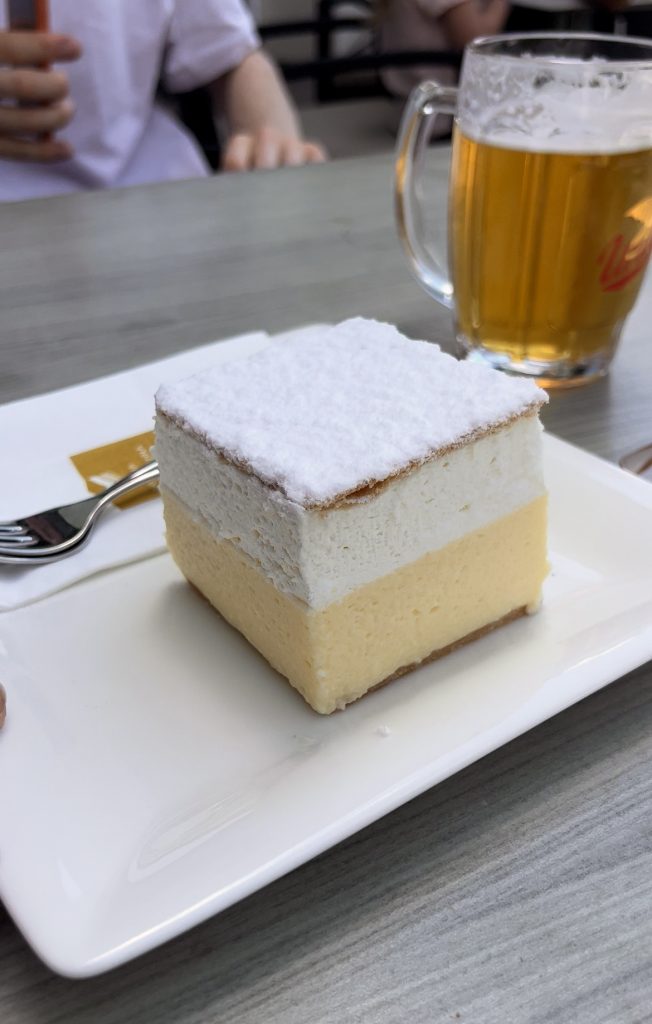
Cockta
Not a food, sorry, but worth trying nonetheless. Cockta originated in Slovenia and was first introduced in the 1950s. It quickly became a popular and iconic beverage in the country. It’s a fair bit like coke, but it has a blend of various natural flavours, herbs, and spices, giving it a unique and distinct taste that sets it apart.
It actually tasted a little like a mild vodka and coke to me, or a mixture between this and Dandelion and Burdock. It is often described as having a slightly herbal and bittersweet flavour profile.
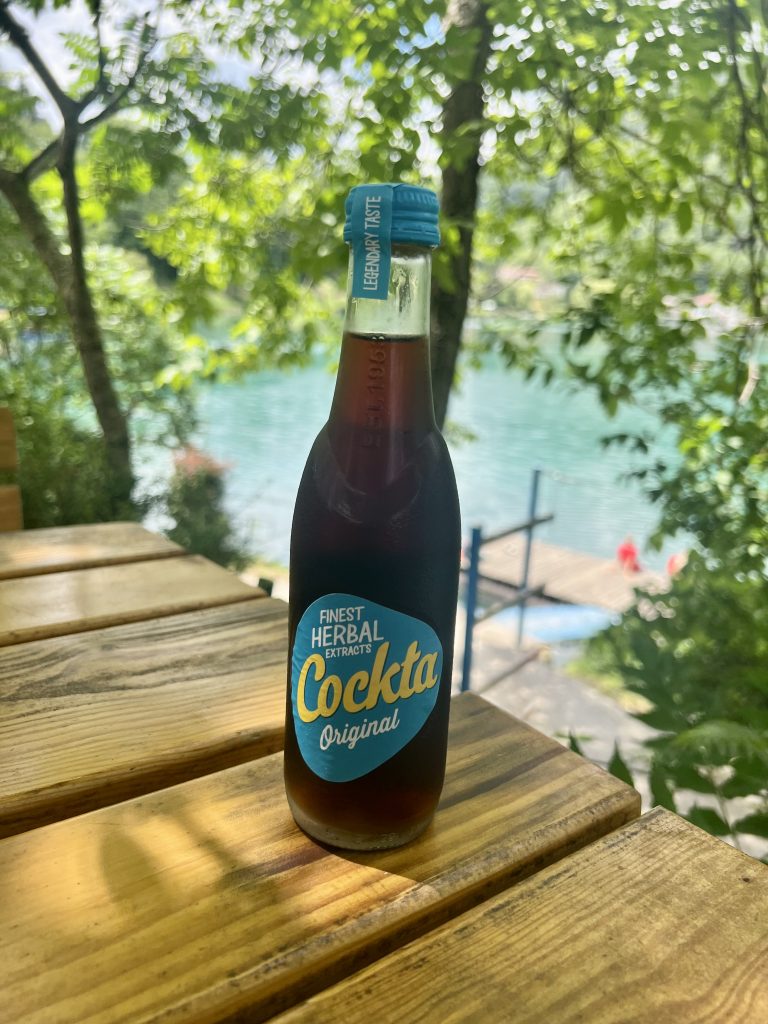
Honey
Honey holds a cherished place in Slovenia, deeply rooted in its culture and traditions. Renowned for its diverse landscape, the country produces a wide array of honey types. With a strong tradition of beekeeping, Slovenia celebrates “World Bee Day” on May 20th. This is testament to the nation’s commitment to preserving bee populations and the crucial role they play in ecosystems. Beyond its culinary uses, honey-inspired products like mead and liqueurs reflect Slovenia’s appreciation for honey, showcasing its significance as a symbol of sustainability, biodiversity, and cultural heritage.
Vegetarian food in Slovenia
On the whole, I found it easy to eat vegetarian food in Slovenia. The country neighbours Italy, so there is always pasta and pizza. I perhaps felt like I was lacking protein options, but if you can stomach the fair amount of cheese on offer in Slovenia then this will help for the time you’re here. When we stayed in a hotel which included dinner, the protein options were few and far between, but there were always vegetables.
You’re going to find the most options and variety in Ljubljana, but even outside the city we felt like Slovenia is making a much better effort than other countries we have visited, where we felt like fries were the only option for days on end. Other than pasta and pizza, I’m sure you’re used to the offering of a vegetarian burger. We usually roll our eyes at yet-another-vegetarian-burger, and it’s true that these were reasonably common in Slovenia. However, we would highly recommend the Beyond Burgers from Karakter Bar in Lake Bohinj.
My guides will always include restaurant recommendations based on places that have a few vegetarian options. Check out the best places to eat and drink in Bled, with stunning views.

